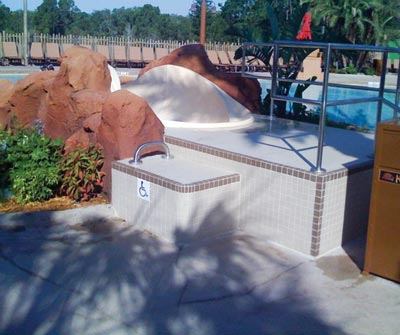After a six-year wait, the Americans with Disabilities Act swimming pool guidelines have become the law of the land.
Commercial aquatics facilities now have 18 months to comply with the new requirements.
“In some ways, this is like a 2011 version of the Virginia Graeme Baker Act,” said John Caden, director of pool lifts at S.R. Smith in Canby, Ore. “VGB brought a lot of turmoil, but also a lot of opportunity.”
Certain sections of the ADA have been revised, and updates include adoption of the 2010 Standards for Accessible Design, which establishes detailed accessibility requirements for pools.
For service technicians, those requirements may pave the way to new business, Caden said.
A provision in the law called “Maintenance of Accessible Features” mandates regular maintenance on pool lifts and similar products; which is work that can be performed by a service tech.
Caden also estimated that approximately 100,000 commercial pools currently are noncompliant, and each of those facilities may need new equipment, and someone to install it.
The law mandates that any commercial pool containing more than 300 linear feet of pool wall perimeter must have at least two means of entry that are wheelchair accessible.
One entry is required to be either an automated lift, or a sloped entry. The second can be a lift or a sloped entry — or it can be one of several other methods: pool access stairs, a transfer system that resembles a set of small portable stairs; or a transfer wall, which is a low wall with handles that helps people lift themselves over the side of the pool.
Pools with less than 300 linear feet of pool wall perimeter need one accessible means of entry: either a lift or sloped entry. Spas need one entry, which can be either a lift, a transfer system or a transfer wall.
Facilities that are not in compliance could face lawsuits and complaints filed against them with the U.S. Department of Justice. So awareness of the new requirements is key for pool professionals, said Ken Sanders, owner of Pool Pro’s in Tucson, Ariz.
“It’s important for service technicians to be aware of the new law and what the requirements are so they can keep their customers up to date,” he explained.
The law will become effective in April 2011, and will apply to all newly constructed commercial pools. Existing facilities will be allowed one year from that date to bring their equipment into compliance with the standards. However, most pool operators and designers have long been using the guidelines, which were first published in 2004.
In view of the signing’s publicity, some manufacturers of lifts and related equipment already have begun spreading the word about their offerings.
“I think … there’s potential for expansion in this market because [legislation] is going to attract people to the category,” said Brett Fritts, vice president of marketing and business development at S.R. Smith. “We could see existing players maybe being acquired, or additional investment made in them. … A company outside the industry that makes complementary types of products might attempt to enter the aquatic access space.”
Others, however, say the ADA law may attract less manufacturer attention than more contentious legislation, such as the VGB Act, has in the past.
“I believe the product marketplace will stay pretty similar,” said Bruce Giffin, national sales manager at Aqua Creek Products, LLC, in Missoula, Mont. “This is more about compliance than about safety.”
He added, though, that he does “see the potential for a slight increase in the marketplace.”


